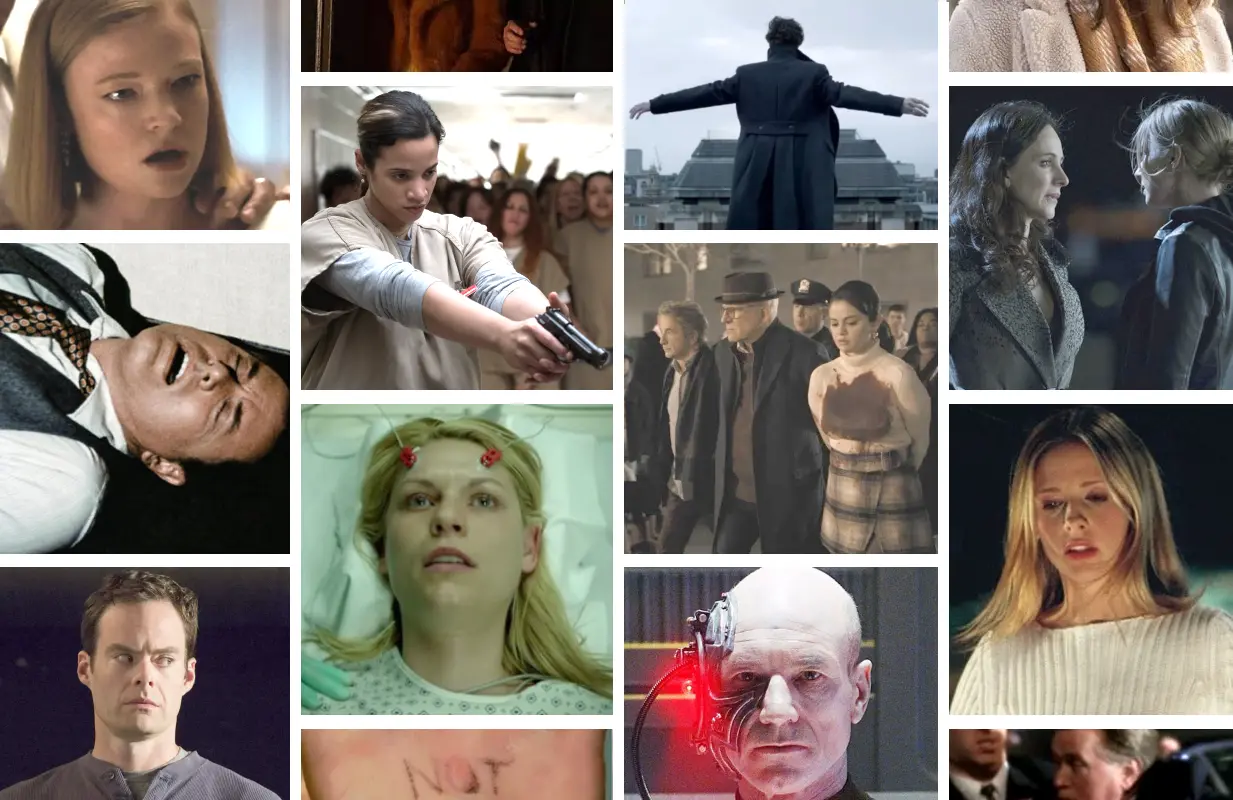A Taxonomy of TV Cliffhangers
-
 Photos: HBO, CBS, Netflix, Showtime, ABC, BBC, Hulu, Paramount, The CW, NBC
Photos: HBO, CBS, Netflix, Showtime, ABC, BBC, Hulu, Paramount, The CW, NBCSometimes TV shows deliver closure: traditional sitcoms usually end their stories in under thirty minutes; procedurals solve most cases by the end of the hour; and miniseries promise they’ll wrap it up in ten episodes or less.
Today more than ever, though, shows keep us hungry. Just like Scheherazade telling 1,001 tales or Charles Dickens drip-feeding his novels one chapter at a time, TV producers use cliffhangers to keep us hooked. Otherwise, we might tune out, and for a TV series, that’s more dangerous than anything cooked up in a writers’ room.
Shows use cliffhangers at the end of episodes or even at the end of an act, but the most obvious place to put them is in a season finale.
Here are the four basic types of season-ending cliffhangers, each with their own strategies to keep us jonesing for that next batch of episodes.
(Warning: there are spoilers ahead, but only for older shows.)
The Hero Is In Danger!
Only Murders in the Building just dropped a teaser for its upcoming second season, but fans have been anticipating it since the last scene of season one, when the three main characters suddenly found themselves in the middle of a new crime. A new crime… for which they might be framed!
This cliffhanger works because it drops us into a crisis with characters we care about, then yanks us right back out of it. Will they survive? What if they get hurt? Someone tell us! Please!
The risk, of course, is overestimating how much we care about a character’s fate, but when it works, you get something like the Season Four finale of Orange is the New Black, with all the women in the midst of a prison riot. It’s bad enough to worry that one character is in danger. It’s worse (or maybe better) to worry about all of them.
Someone Might Be Dead!
This is a step up from putting someone in danger, and television history proves that you can’t know for sure if someone has croaked until the next season actually begins. Is J.R. really dead on Dallas? Or Detective Moss on Barry? Or Victoria Grayson on Revenge? Playing out the scenarios is part of what keeps the show in our minds until it comes back.
Some series lose their nerve with this gambit, like when Stranger Things revealed a major character wasn’t really gone in the post-credits sequence of the very same episode where they maybe died. In the best cases, though, the approach can spark a phenomenon.
This Moment Changes Everything!
It doesn’t always have to involve gunshots or explosions: A cliffhanger can be made with nothing more than a sentence or a look or a camera shot.
Take Homeland’s season one finale, when Carrie Mathison realizes Brody is a double agent just moments before she has her memory wiped by electroshock therapy. Will she remember the crucial detail she blurts out to a room of uncomprehending med techs, or will we spend the entire second season screaming secrets at the TV? Similarly, the third season of Succession ends with a facial expression that tells you one of the show's characters is going to wreak havoc very soon.
On the other hand, Heroes kept trying things like this, but the revelations were often so vague that they were more confusing than exciting.
That’s the trick here: You have to make your information specific enough to matter, but spare enough to leave us tantalized. It’s a delicate balance, but when it succeeds, it’s possibly the most elegant cliffhanger of all.
A New Character Is Coming!
A cousin to the last-minute revelation, this type of cliffhanger wants us to get tingly at the prospect of someone’s arrival.
And honestly, it fails more often than it succeeds. Remember when Brothers & Sisters tried to get us hyped by revealing at the end of Season 2 that Rebecca wasn’t really a Walker and there was a different illegitimate sibling out there? It was ludicrous, and it obliterated years of storytelling work on Rebecca’s behalf. Or how about when Orphan Black teased the existence of male clones in its Season 2 finale? When the show returned, it was quickly apparent that they were all dead weight, and they all got killed off. Oops!
But if the introduction of new people is crucial to a show’s storytelling, this cliffhanger can soar. The best recent example is in Yellowjackets, which spent the entire first season teasing us with the idea that there are adult survivors we haven’t yet met. By actually naming one in the finale — but not yet showing us what they look like — the show is makes good on a narrative promise. That’s the kind of payoff that makes a cliffhanger delicious.
Mark Blankenship has been writing about arts and culture for twenty years, with bylines in The New York Times, Variety, Vulture, Fortune, and many others. You can hear him on the pop music podcast Mark and Sarah Talk About Songs.
TOPICS: Only Murders In The Building , Barry, Brothers & Sisters, Dallas (1978 series), Heroes, Homeland, Orange Is the New Black, Revenge, Succession, Yellowjackets